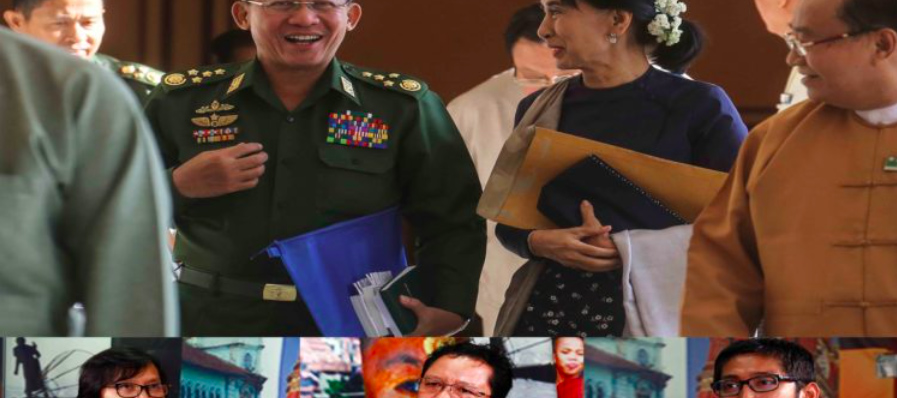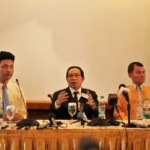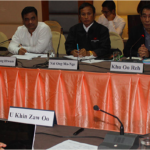The Irrawaddy | November 5, 2016
Kyaw Zwa Moe: Welcome to Dateline Irrawaddy! We have repeatedly heard about peace over the past five or six years across the country. Daw Aung San Suu Kyi’s administration believes peace is a top priority for the country’s political stability and is working to achieve it. But at the same time, there are continued clashes between the Burma Army and ethnic armed groups near the border areas. We’ll be discussing where the peace process is now—if it has stalled, or is moving forward or backward—and whether Daw Aung San Suu Kyi’s political goals for national reconciliation and peace over the next four or five years are realistic. U Sai Leik, joint general secretary-1 of the Shan Nationalities League for Democracy (SNLD)
Speaking of conflict, war and peace, Ko Ye, your institution has studied these topics in depth. We have heard lots of talk of peace ever since former President U Thein Sein’s government assumed power in 2011, but the peace process has failed to make progress in certain aspects as clashes continue. It seems that clashes have even intensified lately. Clashes should have deescalated after Daw Aung San Suu Kyi’s 21st Century Panglong Conference, but instead the reverse is happening. Where is the peace process now? Is the amount of clashes high or low?
Ko Ye: Today, it is generally accepted that we are moving toward peace. Daw Aung San Suu Kyi held the 21st Century Panglong Conference and is trying to achieve peace through political means. But the reality is that we are still in a circle of conflict that we can’t yet break out of. From last October until this September, there were 304 clashes according to our statistics. From this January until September, there were 207 clashes and from the power transfer [in April] until September, there were 110 clashes. This is a pretty high number.
KZM: Do these figures represent only the clashes between the Burma Army and ethnic armed groups or do they also include clashes between ethnic armed groups?
KY: Only the clashes between the Burma Army and ethnic armed groups. This is a pretty high number given that we are in the midst of an ongoing peace process. Despite the so-called peace process, we still hear gunfire, smell blood, and see the troubles displaced persons are facing in the camps. Even a genuine ceasefire has not yet been achieved.
KZM: U Sai Leik, Daw Aung San Suu Kyi’s government held the 21st Century Panglong Conference at the end of August. Many ethnic groups attended the conference, which contributed a lot to the government’s peace policy. But there is a question about whether the Burma Army is cooperating. Before the conference, clashes renewed in Kachin State on Aug.17. The Burma Army reportedly used fighter jets and a two-year-old girl was allegedly killed by artillery fire. Why are there clashes? Are they deliberate military attacks or is it just lower-level friction on the ground?
Sai Leik: Frankly speaking, there may be a misunderstanding between the government and the military. Daw Aung San Suu Kyi’s government held the 21st Century Panglong Conference, which was wrong from the very beginning. The conference was said to be all-inclusive but not every group was allowed to attend. As far as I’m concerned, they could not attend because of restrictions by the military. I doubt that the government’s peace process and the military’s peace process are the same. The military has its own six peace principles and the government has a seven-point peace policy and there are conflicts between the two. The question is if the process can progress.
KZM: Despite Daw Aung San Suu Kyi and her government preaching and working toward building peace, there are hundreds of clashes on the ground, which could intentionally or unintentionally undermine the peace process and peace negotiations. How can these clashes be stopped?
KY: It is incorrect to say the problem is in the lower levels because the military used fighter jets that would not be used without a decision from top-level management. Looking at the ongoing conflicts, I found two points. One is that the rhetoric about the decades-long war in our country remains the same. One side says they are fighting a fair war and the other side says they are fighting for equality. They only think about how to justify the fighting. They still can’t solve the problem through non-violent means. So, the rhetoric itself is a problem.
Another thing is in regards to tactics. They fight with the intention of killing rather than putting pressure on the other side. So, it is quite difficult to stop these conflicts. There have been calls for peace and national level dialogue but there have been no equitable developments between the two. It is difficult for the peace process to move forward while conflicts still can’t be solved. If this continues, the peace process will reach a deadlock. We have already seen a certain degree of deadlock in the peace process. Another problem that contributes to the deadlock is technocratic peace, which is overly-focused on technicalities without looking at the underlying causes and grievances on the ground. I am concerned that the peace process will become too technical.
KZM: The former U Thein Sein government had a lot of [peace] advisers. I spoke with them and most of them talked about technical issues such as what provisions the NCA [Nationwide Ceasefire Agreement] should include. They only discussed about technical things when they spoke with international peace academics. We should question how much people are suffering [from wars] and how strong the political will [of leaders] for peace is.
U Sai Leik has also questioned the collaboration between the government and the military. This is a big question. We can’t gauge the depth of the relations between Daw Aung San Suu Kyi and the commander-in-chief. The two are of course always seen smiling together in pictures, but we don’t know how good their relationship is in reality. For example, the government has not said a single word about the military’s attacks in Kachin State. So more than 20,000 locals staged a demonstration in Kachin State. The question is why the government has kept silent.
Are they not in a position to tell Snr-Gen Min Aung Hlaing that the attacks should be stopped? What is your view on the collaboration between the two sides?
SL: I think it will concern the political interests of each individual and each group. Given their actions, it is obvious that they are building a political empire. It will lead to bad results as Ko Ye has said because ethnic armed groups, on the other hand, will also try to protect and promote their own political interests. The suggestion I would like to make is, it is not enough to just build good relations between Daw Aung San Suu Kyi’s government and the military. Only when a tripartite relationship is established [between the government, the military, and ethnic armed groups] can the root-causes of the problem be found. And while the upper levels are only thinking about their political gains, if the [peace] academics only give advice from a technical point of view, it will be more difficult to achieve peace. So in a nutshell, tripartite dialogue is a must to find out how to reconcile relations between civilians and the military, as well as among civilians, because reconciliation between the government and the military is just not enough.
Another thing is that top leaders meet few other people in our country. The government and ethnic armed groups may meet, but the new government has hardly met other influential people or association members in ethnic regions. This is not good. The last thing is, there is no strong opposition [party]. As a result, no one dares to criticize the government. There is no one who will point out the faults of the government. We need a good opposition. If there is a good opposition, as well as public cooperation, we can have hopes.
KZM: We have also been talking about national reconciliation and a democratic, federalist union, which is a long-term process for which peace needs to be built. But if we focus on ongoing conflicts, do you think it is possible to hold tripartite negotiations? Over the past 20 years, dialogues were called for, but they never happened. There was dialogue under U Thein Sein’s government, but it was only nominal. Will the military be willing to accept a dialogue if the government were to call for one now?
KY: I think that, rather than forcibly putting the existing problems into a technical framework, only genuine political dialogue will be able to break the existing gridlock.
KZM: What do you mean by “genuine political dialogue”? What yardstick could you use to measure this?
KY: By “genuine political dialogue,” I mean dialogue that focuses carefully on how to handle the existing reality. There are existing conflicts. But they don’t discuss those conflicts. Instead, they leaped to the next stage and make calls for peace with a grand vision for 2020 or 2025. The existing conflicts are the major problems the country is facing. If those problems can’t be solved, it is not genuine political dialogue. Again, there is a saying that if a country has so many reconciliation events, it shows that that country still does not have reconciliation. We need to be careful that there are not too many events.
Another thing concerns local and international academics. Peace is not a luxury item for academics. Peace is a real problem. Rather than making it a technocratic peace [process] for academics, they should focus on solving the real problems. Our country is ranked 148th out of 188 countries on the human development index, and we are behind Laos and Cambodia. And we are ranked 199th out of 199 countries on the health care index recently released by the WHO. Regarding the poverty rate, we are the poorest among Asean members, at 25.6 percent. This highlights the need for our political leaders to solve existing problems in order to move to the next stage. They should consider these things, take a pragmatic approach, and make swifts steps to hold negotiations.
KZM: The problem can’t be solved if one side does not accept it, even if the other side does. As U Sai Leik said, if they are just working toward some future mission with some big political aim, it is impossible to engage in people-oriented peace. Also important is the means for building peace. Leaders, most importantly Daw Aung San Suu Kyi, and ethnic leaders, especially leaders of armed ethnic groups, should find various solutions.
Recently, the government announced a seven-point national reconciliation and peace policy. Besides signing agreements from peace conferences, the policy includes amending the undemocratic 2008 constitution, based on those agreements. Only after the constitution is amended will elections be held in accordance with this amended constitution. This is the sixth point of the policy. Although Daw Aung San Suu Kyi does not disclose the timeframe officially, I assume she’s referring to 2020 [elections]. This is because if the timeframe is too long, peace and conflict will clash and we will be back to the status quo, unable to move out of this vicious cycle of civil war. The seventh point is to build a democratic federal union in line with the results of multi-party democratic elections. This may be the ultimate aim. I would like to question the timeframe. It is only five years from now. What can be done in these five years? What is the major obstacle, though there are of course many smaller challenges?
SL: There are seven points in the NLD’s peace and national reconciliation policy. With point sixth, a new constitution will be drafted and approved based on agreements reached at the 21st Century Panglong Conference. And a multiparty general election will be held in accordance with the constitution. This is to counter Section 436, which reserves 25 percent of parliamentary seats for the military. It’s a good idea. But is it possible? The most important thing is, how much is the military willing to cooperate? If the military disagrees, it is difficult to move forward. So the most important thing to keep in mind is, to what extent can we persuade the military. If all ethnic armed groups, all political parties, and the government are on one side and the military is on the other, it will surely participate.
KZM: At the Panglong [conference], what Daw Aung San Suu Kyi said was much in line with what ethnic armed groups like the KIO [Kachin Independence Organization] and KNU [Karen National Union] said in terms of policy. They said that they support the policies of Daw Aung San Suu Kyi. Is the military the only group that has different policy priorities?
KY: In my opinion, the military wants to cling to the 2008 constitution, the current NCA framework, and to the six-point peace principles of the military chief. Apart from other groups, Daw Aung San Suu Kyi herself has talked about amending the constitution, which clearly shows that she has different views from the military. On the anniversary of the NCA signing, KNU chairman Saw Mutu Say Poe said that he wanted the Burma Army and the government to grant certain concessions in order to keep the peace process moving. If the military clings to its policies, the peace process will end up in gridlock. To overcome this, Daw Aung San Suu Kyi—we know that she is a leader who emphasizes dialogue—ethnic leaders, and the military should hold parallel dialogues in order to break the existing gridlock.
KZM: Throughout the entire peace process, leaders are of course important, but are there people on peace committees who are not very serious about achieving peace? Are their actions creating problems for the peace process? Before the peace conference in August, retired Lt-Gen Khin Zaw Oo gave us an interview about the conference, and some ethnic groups were not happy with what he said. Have you seen similar actions that have supposedly undermined the peace negotiation at the lower level?
SL: Yes, we have seen such things on both sides. Among ethnic armed groups, there are NCA signatories and non-signatories, as well as groups that think they don’t need to sign the NCA. One of the leaders of the NCA signatories has implied that he would move forward according to the NCA timeframe, so the political dialogue will be held in February, as scheduled, and the groups that still have not signed the NCA by then will be left behind. This is not a constructive approach. And we have to question the [motives of the] military. Regarding the tensions between Wa and Mongla groups, we have to question if the military played a part in causing these tensions. Likewise, the military clashed with the SSPP [Shan State Progressive Party/Shan State Army-North] and the RCSS [Restoration Council of Shan State/Shan State Army-South], and it is clashing with the KIA [Kachin Independence Army]. Does the military view those fights as necessary? We need to assess if they are fighting in order to pressure groups into signing the NCA, or if they are fighting because they don’t want them to sign the NCA? So, yes, I would say that there are undesirable people and attitudes in this circle.
KZM: It is fair to say that this problem has been around since our country gained independence in 1948—well over 60 years ago—and that people are still suffering from this problem—we still hear gunfire. Many people, including us, have called on leaders to end this problem, and both of you made some suggestions earlier. What else would you say to leaders?
KY: First of all, it is important that leaders have political will. There should be the political will to serve the interests of the people. Likewise, the second-level peace negotiators appointed by them—there are ethics of negotiation and ethics of peace processes—should observe those ethics carefully so as not to offend the other side and to keep the peace process moving.
SL: Ethics are critically important. At the same time, not only top leaders but also second-level peace negotiators should see each other as equals. Leaders belong to different ethnic groups, which differ from one another in size. But it is critically important that they view each other as equals. Only then will we achieve national reconciliation and internal peace, things we aspire for. The seven-point peace policy of Daw Aung San Suu Kyi is very good. I think it can be beneficial to both sides. But then, there may also be people who will rock the boat out of self-interest, and we need to be careful about that.
KZM: Well, we’ll wait and see what happens with the peace process. Every citizen in our country wants peace. But I don’t know what will happen, and neither do the people. It is fair to say that the destiny of our country’s peace will be determined by a handful of leaders.
This article originally appeared on The Irrawaddy on November 5, 2016.







